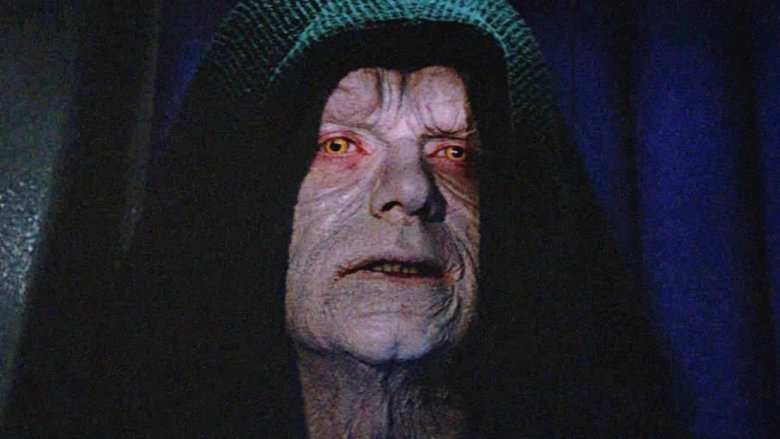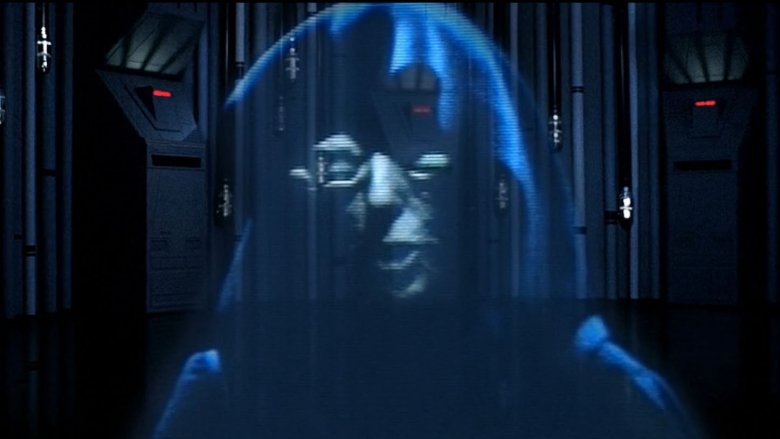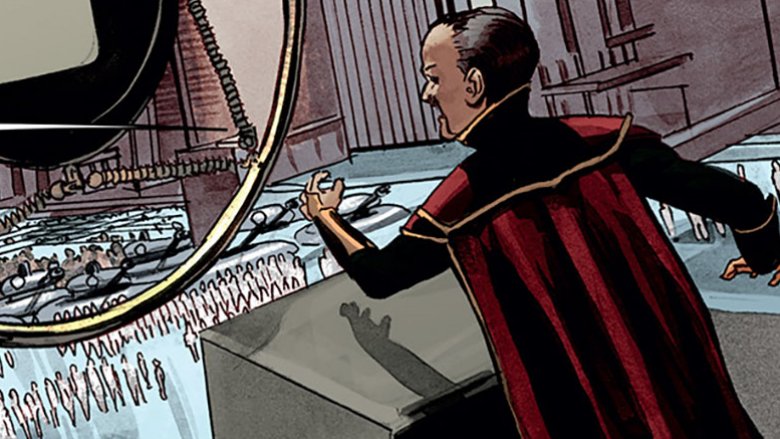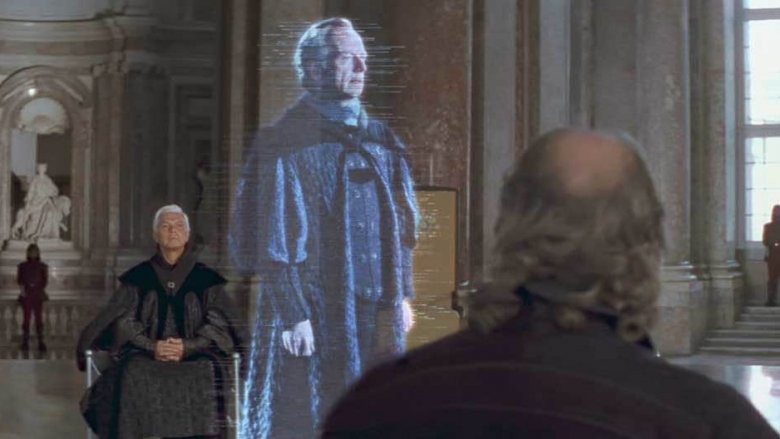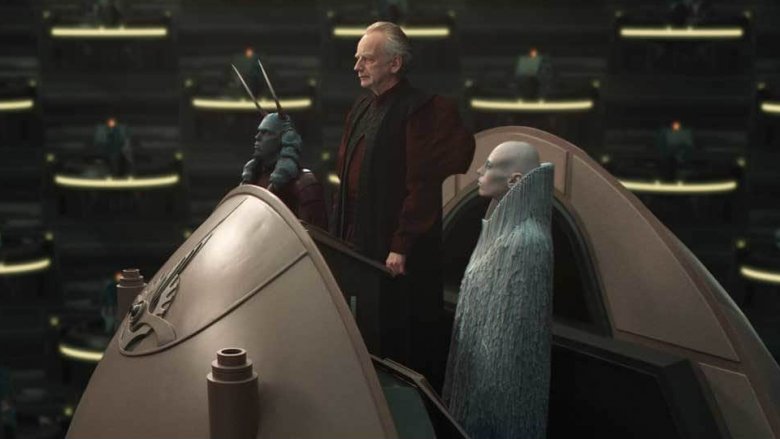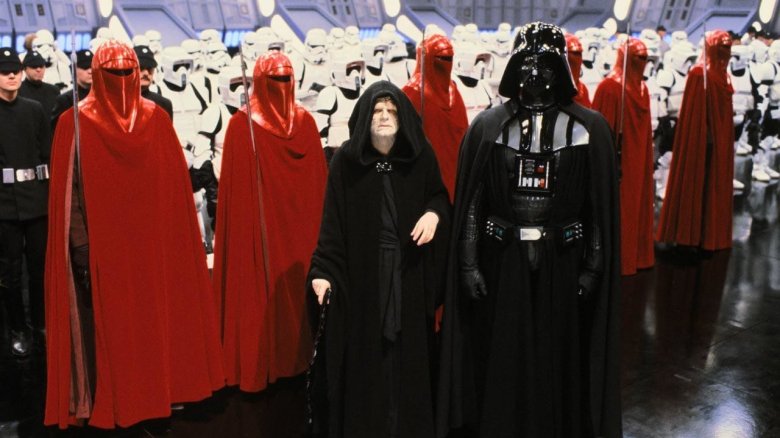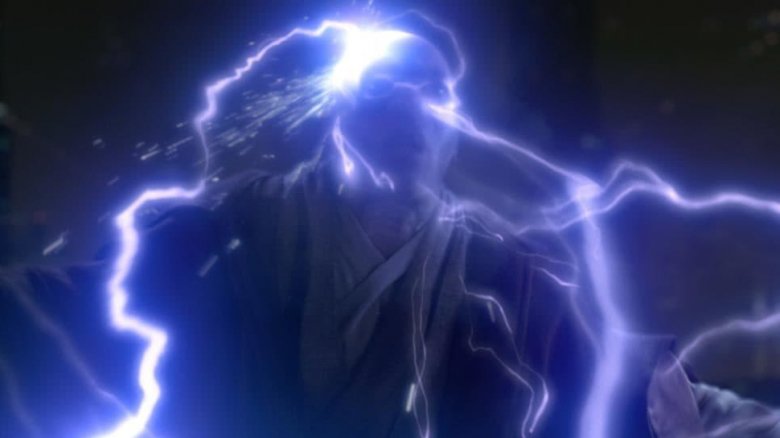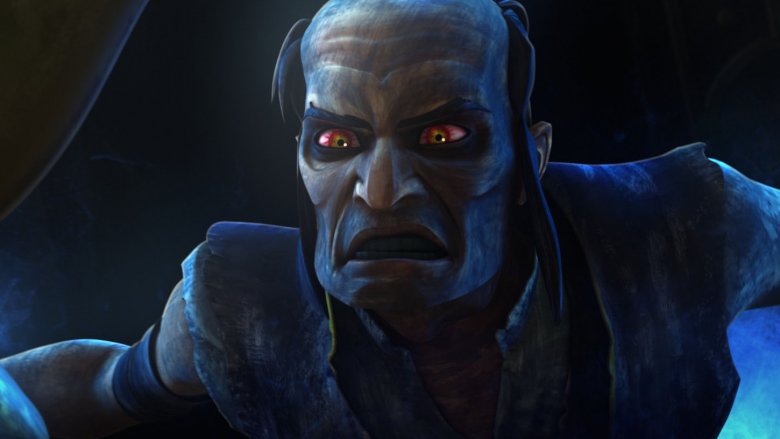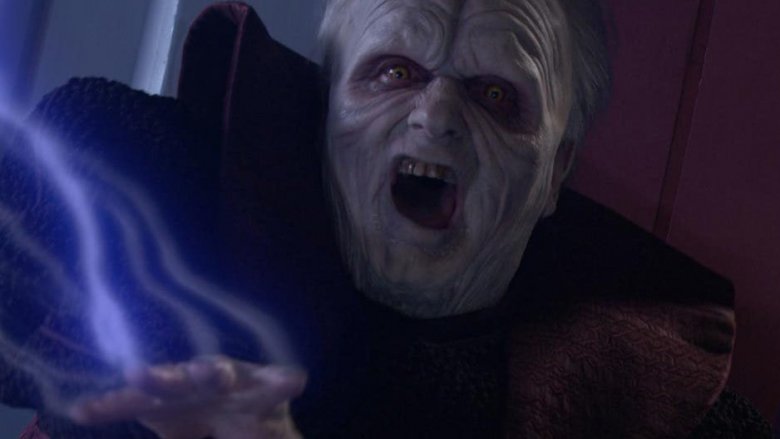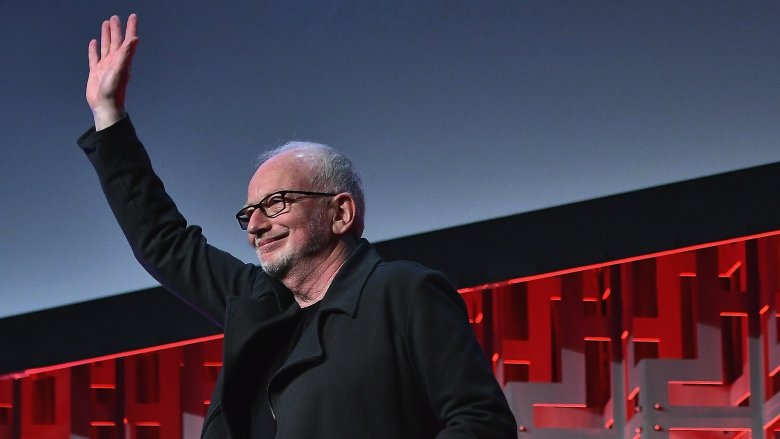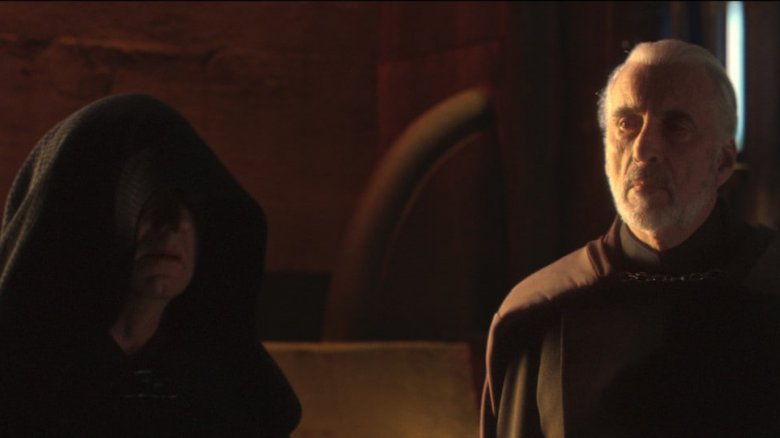False Facts About Palpatine You Always Thought Were True
Emperor Palpatine, also known as Darth Sidious, the Dark Lord of the Sith is back. That's right: 36 years after Darth Vader tossed his one-time master down the second Death Star's reactor shaft, the former Senator of Naboo and leader of the Galactic Empire is returning to plague the galaxy once again in Star Wars: Episode IX — The Rise of Skywalker, and he's bringing all of his deepest, darkest secrets with him.
After all, Palpatine isn't just an evil space wizard. He's the most corrupt of corrupt politicians, and he tends to play his cards close to his black-clad, wrinkly chest. As a result, much of the information that's out there about Palpatine simply isn't true. Misinformation and propaganda are some of the most potent weapons in the Emperor's arsenal, which is why we're here to help set the record straight. Don't buy into the rumors. That's how a despot like Emperor Palpatine wins.
He was always played by the same actor
When you think of Emperor Palpatine, you probably think of Scottish actor Ian McDiarmid. After all, McDiarmid played the Emperor in almost all of his major appearances. He's the man behind the makeup during Palpatine's first major appearance in Return of the Jedi, he plays the conniving Chancellor in all three of George Lucas' prequels, he provided Palpatine's voice for the Emperor's cameos in Star Wars Rebels, and he's coming back to play the mysteriously resurrected dictator in The Rise of Skywalker, too.
But McDiarmid wasn't the first person to portray Palpatine on-screen. For the Emperor's brief appearance in The Empire Strikes Back, Palpatine was actually played by one man, two women, and one wild animal. Actress Marjorie Eaton provided the Emperor's face for the final movie, while makeup artist Rick Baker tested Eaton's prosthetics on his wife, Elaine. Clive Revill, an accomplished actor and friend of Empire director Irvin Kershner, provided his voice. Palpatine's eerie yellow eyes, meanwhile, weren't human at all: They belonged to a chimp and were superimposed over Eaton's during post-production.
George Lucas replaced the Eaton-Revill-ape hybrid with new footage featuring McDiarmid for the 2004 DVD release of The Empire Strikes Back, but a few other actors took on Palpatine after that, too. In the early seasons of The Clone Wars animated series, The Wizards of Waverly Place's Ian Abercrombie voiced Emperor Palpatine. After Abercrombie passed away, the role was taken over by Tim Curry, superstar of Rocky Horror Picture Show, Clue, and It.
Palpatine was always the Star Wars Universe's big bad
The Emperor has always been part of Star Wars lore — it's kind of hard to have an empire without one — but it wasn't always Palpatine, and he wasn't always the series' main villain. In George Lucas' earliest full draft of Star Wars (which was adapted into a comic book miniseries called The Star Wars), the Emperor was Cos Dashit, "a thin, grey looking man, with an evil mustache which hangs limply over his insipid lip." Dashit was't Force-sensitive. He wasn't that scary, either, and Darth Vader spent a good deal of the movie plotting to undermine Dashit's authority.
By the time the final movie rolls around, the Emperor is known as Palpatine, but he's still not the Palpatine that we love to hate. In Alan Dean Foster's official Star Wars novelization, Palpatine is depicted as a recluse who disappeared from public view, and who was quickly manipulated and "controlled by the very assistants and boot-lickers he had appointed to high office."
Like all the other Star Wars film novelizations, Foster's book was considered in-continuity until other canon materials explicitly contradicted it. That means that, until The Empire Strikes Back rolled around, Emperor Palpatine wasn't really the villain. The "Imperial governors and bureaucrats" who "used the Imperial forces and the name of the increasingly isolated Emperor to further their own personal ambitions" were the villains. That includes figures like Grand Moff Tarkin, who oversaw the Death Star's construction, and Darth Vader. Compared to them, old Palpy was just an afterthought.
We don't know his first name
In the original Star Wars trilogy, he was just known as the Emperor. Later, supplementary materials like novels, role-playing games, and screenplays taught us that his last name was Palpatine. The prequel trilogy taught us that he was from the planet Naboo, and that he's known among the Sith as Darth Sidious, but so far, Emperor Palpatine's first name hasn't ever been spoken on-screen.
That doesn't mean that he doesn't have one, of course. It just took a long, long time for fans to learn it. In 2014, several decades after the Emperor's big screen debut, Del Rey Books published Tarkin, one of the very first novels in the new, Disney-approved Star Wars canon. While the book's plot centers on the rise of Wilhuff Tarkin, a former Clone Wars soldier who rose through the Imperial ranks to become the Empire's very first Grand Moff, it does contain one crucial piece of trivia for Palpatine fans: the former Chancellor's first name is Sheev.
Yes, that's maybe kind of silly, but most of Naboo's citizens have names that appear to be derived from Sanskrit, so Sheev fits, and with good reason: George Lucas himself came up with it. As Tarkin author James Luceno, who has written many Star Wars novels, explains, Lucas shared the name while working on Underworld, the live-action Star Wars television show that Lucasfilm worked on for years. Lucasfilm's story group gave the name to Luceno, and he put it in Tarkin. The Star Wars universe just hasn't been the same since.
He was an analogue for George W. Bush
The Star Wars prequel trilogy came out between 1999 and 2005, meaning that both Attack of the Clones and Revenge of the Sith hit theaters during the heart of the 9/11 era. As a result, many commentators saw some parallels between Palpatine's plan, which involves a democratic government slowly condeding power to a single individual during a time of war, and the George W. Bush administration, which some criticized for allegedly ramping up America's military while eroding civil liberties with legislation like the Patriot Act.
Given George Lucas' left-leaning political views, it didn't take much for observers to make a connection between Palpatine's take-over of the Galactic Senate and the rhetoric coming out of the White House. They were wrong. As it turns out, Palpatine was based on a United States president. It just wasn't Bush. Lucas told the Chicago Tribune that Star Wars "was really about the Vietnam War, and that was the period where Nixon was trying to run for a [second] term." That got Lucas thinking, he said, about how "democracies aren't overthrown; they're given away."
And all those supposed Bush similarities? Just a coincidence. Films this big are written years in advance, and while the timing seems suspicious, any modern political parallels weren't planned at all. Not that Lucas was surprised that they happened anyway, of course. "No matter who you look at in history, the story is always the same," he said.
He was insanely old
Given how Emperor Palpatine looks, you might think that he was ancient, especially since his master was Darth Plagueis the Wise — you know, the Sith who mastered the secret of eternal life (and who, Palpatine implies, passed all of his knowledge on to his power-hungry apprentice)? According to Leland Chee, the keeper of Lucasfilm's old continuity repository, the Holocron, that's not the case at all. According to Lucasfilm's official timeline, Palpatine was born a mere 82 years before the first Death Star was destroyed at the Battle of Yavin, making him only 86 when Darth Vader killed him. Much of the old Holocron information is no longer canon, of course, but allusions in Disney-approved material like the novel Tarkin imply that Palpatine's age hasn't changed much, if at all, in this brave new era. So, ugly, yes. Old, not so much.
As it turns out, that was very good news for Ian McDiarmid. McDiarmid was only 37 when he played Palpatine in Return of the Jedi, but his age didn't matter then because he was wearing makeup. By the time that The Phantom Menace rolled around, during which Palpatine looks pretty normal, McDiarmid and his villainous alter-ego were about the same age. Thank goodness, too: "I don't want anyone else to play him," McDiarmid has said.
He killed Mace Windu
The last time that we saw Mace Windu, the purple-lightsaber-wielding Jedi played by Samuel L. Jackson, Palpatine was pushing him out of a mile-high window with a hearty blast of Force lightning, presumably sending to his death. But this is Star Wars: If you don't see a body (or, sometimes, even if you do), they might still be alive.
That's what Jackson says, anyway. Jackson argues that "Jedi can fall [from] incredibly high distances and not die," so in his mind, Windu is still around. He's just laying low, like Obi-Wan Kenobi did on Tatooine and Luke Skywalker did on Ahch-To. He's gotten support for that idea from an authority, too: In an interview with Entertainment Weekly, Jackson reveals that he ran the idea by none other than George Lucas. According to Jackson, Lucas approved. "George is like, 'I'm okay with that. You can be alive,'" Jackson says.
Of course, Lucas sold Star Wars and the rest of Lucasfilm to Disney, ending his time as the arbiter of all things in a galaxy far, far away. As of now, it's not officially canon — but if you think about it, it's not not canon, either. Hey, if Palpatine himself can make a surprise return from the supposed-dead, who's to say that Mace Windu can't, too? At the very least, Jackson has said he would be up for it.
He created the clones
Who is Sifo-Dyas? Attack of the Clones never explains. When Obi-Wan Kenobi tracks Jango Fett to the planet Kamino, he discovers that a Jedi named Sifo-Dyas commissioned a clone army in secret that the Kaminoans had been working on for years. Then, a fight breaks out. By the end of the film, the clones are fighting in the service of Palpatine and the Republic, Jango Fett is dead, and the mystery of Sifo-Dyas is long forgotten.
Of course, the clone army is clearly a huge piece of Palpatine's plan to assume power, and all of the clones have Order 66, the code that tells them wipe out all of the Jedi, embedded in their brains. Attack of the Clones doesn't lay it out explicitly, but the implication is that Palpatine himself created the clone army — and might even be Sifo-Diyas, using an alias. But is that true? Well, yes and no.
As the Clone Wars episode "The Lost One" explains, Sifo-Dyas was a real person, and he did commission a clone army in secret, shortly after he was expelled from the Jedi Order for his radical views. So, that was Sifo-Dyas, not Palpatine. A little bit later, Palpatine hired a criminal syndicate to kill Sifo-Dyas and had Darth Tyrannus take his place, overseeing the clones' development. That's how Jango Fett got involved, where Order 66 came from, and so on. Palpatine was absolutely instrumental in molding the clone army into what it became. Was he responsible for its creation? Eh, not so much.
He was scarred by Force lightning
Revenge of the Sith goes out of its way to explain why Palpatine looks like a normal middle-aged man in the prequels, but is considerably more monstrous in the original Star Wars trilogy. During Palpatine's fight with Mace Windu, the Jedi master uses his lightsaber to reflect Palpatine's Force lightning back on him. When the lightning hits Palpatine's face, he transforms. Problem solved, right?
Except that's not how Force lightning works. Luke wasn't scarred when the Emperor hit him with Force lightning in Return of the Jedi. Neither were Anakin or Yoda when Count Dooku zapped them in Attack of the Clones, or Kylo Ren when he was electrocuted by Supreme Leader Snoke. Heck, in the exact same Revenge of the Sith scene, Palpatine hits Windu with a round of lightning, and he looks just fine — until he's flung out of the window, anyway.
In The Star Wars Insider #82, Ian McDiarmid explains that Palpatine's evil visage is "what he always looked like," and that his kindlier look is just a "carapace." With Palpatine dropping his nice guy facade, there's no reason to hide his true face. Matt Martin, a member of Lucasfilm's Story Group, has his own (unsanctioned) theory: Palpatine was exerting so much power that the dark side, not the lightning strike itself, warped his looks. Various reference books have similar explanations. There's no clear explanation for the discrepancy in canon, but it's clear that there's more going on than simple scarring. Works in mysterious ways, the dark side does.
His big comeback was a last-minute adjustment
Disney and Lucasfilm have admitted that their sequel trilogy, which began with The Force Awakens and wraps up with The Rise of Skywalker, wasn't planned in advance. A couple of weeks before The Force Awakens premiered, Lucasfilm president Kathleen Kennedy told Variety that "We haven't mapped out every single detail yet." Rian Johnson didn't begin writing The Last Jedi until Episode VII was already well into development, and he wasn't given any direction or notes regarding the movie's plot. Disney and Lucasfilm are making it all up as they go along.
Palpatine seems to be one big exception. While it'd be easy to dismiss the Emperor's upcoming appearance in The Rise of Skywalker as a last-minute ploy to shock audiences, it's apparently been in the works for a while. At Star Wars Celebration 2019 in Chicago, Kathleen Kennedy told Yahoo that Palpatine's return has "been in the blueprint for a long time." She adds, "We had not landed on exactly how we might do that, but it was always" going to be part of Episode IX.
Exactly how Palpatine will return remains a mystery (although fans have some theories), but whatever happens, don't leave Episode IX thinking that the Emperor's triumphant return was just thrown together. According to Lucasfilm, this has been the plan all along.
He trained Count Dooku
Most masters teach their apprentices. That is, quite literally, the whole point of having an apprentice in the first place. Not Palpatine. Now, to be fair, Darth Sidious did train Darth Maul — after stealing him from his mother. Anakin learned the basics about the Force from the Jedi Order, but Palpatine spent over a decade subtly guiding young Skywalker's career from afar, and taught him some new tricks once he became Darth Vader, too.
But with Count Dooku, Palpatine took a shortcut. See, unlike Maul or Anakin, Dooku was already a full-fledged member of the Jedi — trained by Yoda, even — when Palpatine got his hooks in him. As revealed in a scene that was cut from Attack of the Clones, Dooku had already forsaken the Jedi in favor of his ancestral money and power, renouncing his Jedi vows and becoming a member of the mythical "Lost Twenty."
Rumors suggested that Dooku was planning to found his own Jedi order, but fate had other plans. When Darth Maul died at Obi-Wan Kenobi's hands after killing Dooku's former apprentice, Qui-Gon Jinn, Palpatine needed a replacement, and he needed one fast. Dooku, who had already mastered the Force and proved that he was sympathetic to the dark side, was right there. We don't know the complete story, but Palpatine recruited Dooku, renamed him Darth Tyrannus, and had a ready-made henchman right away. No muss, no fuss.
